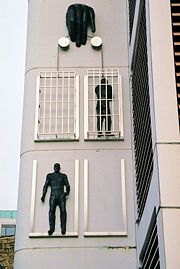Prison
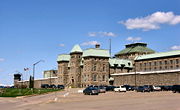
A prison, penitentiary, or correctional facility is a place in which individuals are physically confined or interned and usually deprived of a range of personal freedoms. Prisons are conventionally institutions, which form part of the criminal justice system of a country, such that imprisonment or incarceration is a legal penalty that may be imposed by the state for the commission of a crime.
In popular parlance of many countries, the term jail (gaol) is considered synonymous with prison, although legally these are often distinct institutions: typically jails are intended to hold persons awaiting trials or serving sentences of less than one year, whereas prisons host prisoners serving longer sentences.
A criminal suspect who has been charged with or is likely to be charged with a criminal offense may be held on remand in prison if he or she is denied, refused or unable to meet conditions of bail, or is unable to post bail. This may also occur where the court determines that the suspect is at risk of absconding before the trial, or is otherwise a risk to society. A criminal defendant may also be held in prison while awaiting trial or a trial verdict. If found guilty, a defendant will be convicted and may receive a custodial sentence requiring imprisonment.
Prisons may also be used as a tool of political repression to detain political prisoners, prisoners of conscience, and "enemies of the state", particularly by authoritarian regimes. In times of war or conflict, prisoners of war may also be detained in prisons. A prison system is the organizational arrangement of the provision and operation of prisons, and depending on their nature, may invoke a corrections system. Although people have been imprisoned throughout history, they have also regularly been able to perform prison escapes.
Contents |
History
For most of history, imprisoning has not been a punishment in itself, but rather a way to confine criminals until corporal or capital punishment was administered. There were prisons used for detention in Jerusalem in Old Testament times.[1] Dungeons were used to hold prisoners; those who were not killed or left to die there often became galley slaves or faced penal transportations. In other cases debtors were often thrown into debtor's prisons, until they paid their jailers enough money in exchange for a limited degree of freedom.
Only in the 19th century, beginning in Britain, did prisons as we know them today become commonplace. The modern prison system was born in London, as a result of the views of Jeremy Bentham. The notion of prisoners being incarcerated as part of their punishment, and not simply as a holding state till trial or hanging, was at the time revolutionary.
The first "modern" prisons of the early 19th Century were sometimes known by the term "penitentiary" (a term still used by some prisons in the USA today): as the name suggests, the goal of these facilities was that of penance by the prisoners, through a regimen of strict disciplines, silent reflections, and maybe forced and deliberately pointless labor on treadwheels and the like. This "Auburn system" of prisoner management was often reinforced by elaborate prison architectures, such as the separate system and the panopticon. It was not until the late 19th Century that rehabilitation through education and skilled labor became the standard goal of prisons.
Design and facilities
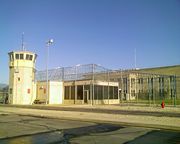
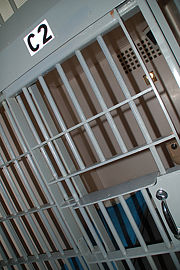
Male and female prisoners are typically kept in separate locations or separate prisons altogether. [2]Prison accommodation, especially modern prisons in the developed world, are often divided into wings. A building holding more than one wing is known as a "hall".
Amongst the facilities that prisons may have are:
- A main entrance, which may be known as the 'gatelodge' or 'sally port' (stemming from old castle nomenclature)
- A chapel, mosque or other religious facility, which will often house chaplaincy offices and facilities for counselling of individuals or groups
- An 'education facility', often including a library, providing adult education or continuing education opportunities
- A gym or an exercise yard, a fenced, usually open-air-area which prisoners may use for recreational and exercise purposes
- A healthcare facility or hospital
- A segregation unit (also called a 'block' or 'isolation cell'), used to separate unruly, dangerous, or vulnerable prisoners from the general population, also sometimes used as punishment (see solitary confinement)
- A section of vulnerable prisoners (VPs), or protective Custody (PC) units, used to accommodate prisoners classified as vulnerable, such as sex offenders, former police officers, informants, and those that have gotten into debt or trouble with other prisoners
- A section of safe cells, used to keep prisoners under constant visual observation, for example when considered at risk of suicide
- A visiting area, where prisoners may be allowed restricted contact with relatives, friends, lawyers, or other people
- A death row in some prisons, a section for criminals awaiting execution
- A staff accommodation area, where staff and guards live in the prison, typical of historical prisons
- A service/facilities area housing support facilities like kitchens
- Industrial or agricultural plants operated with convict labour
- A recreational area containing a TV and pool table

Prisons are normally surrounded by fencing, walls, earthworks, geographical features, or other barriers to prevent escape. Multiple barriers, concertina wire, electrified fencing, secured and defensible main gates, armed guard towers, lighting, motion sensors, dogs, and roving patrols may all also be present depending on the level of security. Remotely controlled doors, CCTV monitoring, alarms, cages, restraints, nonlethal and lethal weapons, riot-control gear and physical segregation of units and prisoners may all also be present within a prison to monitor and control the movement and activity of prisoners within the facility.
Modern prison designs, particularly those of high-security prisons, have sought to increasingly restrict and control the movement of prisoners throughout the facility while minimizing the corrections staffing needed to monitor and control the population. As compared to the traditional landing-cellblock-hall designs, many newer prisons are designed in a decentralized "podular" layout with individual self-contained housing units, known as "pods" or "modules", arranged around centralized outdoor yards in a "campus". The pods contain tiers of cells laid out in an open pattern arranged around a central control station from which a single corrections officer can monitor all of the cells and the entire pod. Control of cell doors, communications and CCTV monitoring is conducted from the control station as well. Movement out of the pod to the exercise yard or work assignments can be restricted to individual pods at designated times, or else prisoners may be kept almost always within their pod or even their individual cells depending upon the level of security. Goods and services, such as meals, laundry, commissary, educational materials, religious services and medical care can increasingly be brought to individual pods or cells as well.
Conversely, despite these design innovations, overcrowding at many prisons, particularly in the U.S., has resulted in a contrary trend, as many prisons are forced to house large numbers of prisoners, often hundreds at a time, in gymnasiums or other large buildings that have been converted into massive open dormitories.
Lower-security prisons are often designed with less restrictive features, confining prisoners at night in smaller locked dormitories or even cottage or cabin-like housing while permitting them freer movement around the grounds to work or activities during the day.
See Panopticon for a historical prison design that has influenced modern designs.
Types
Juvenile
Prisons for juveniles (people under 18) are known as young offenders institutes and hold minors who have been convicted, many countries have their own age of criminal responsibility in which children are deemed legally responsible for their actions for a crime.
- See also: Juvenile delinquency
Military
Prisons form part of military systems, and are used variously to house prisoners of war, unlawful combatants, those whose freedom is deemed a national security risk by military or civilian authorities, and members of the military found guilty of a serious crime.
Political
Certain countries maintain or have in the past had a system of political prisons; arguably the gulags associated with Stalinism are best known. The definition of what is and is not a political crime and a political prison is, of course, highly controversial.
Psychiatric
Some psychiatric facilities have characteristics of prisons, especially when confining patients who have committed a crime and are considered dangerous. In addition, many prisons have psychiatric units dedicated to housing offenders diagnosed with a wide variety of mental disorders.
Rehabilitation
Meta-analysis of previous studies shows that prison sentences do not reduce future offenses, when compared to non-residential sanctions.[3] This meta-analysis of one hundred separate studies found that post-release offenses were around 7% higher after imprisonment compared with non-residential sanctions, at statistically significant levels. Another meta-analysis of 101 separate tests of the impact of prison on crime found a 3% increase in offending after imprisonment.[4] Longer periods of time in prison make outcomes worse, not better; offending increases by around 3% as prison sentences increase in length.[3]
Effective rehabilitation programs reduce the likelihood of re-offense and recidivism.[4] Effective programs are characterised by three things: first, they provide more hours for people with known offense risk factors (the Risk Principle); secondly, they address problems and needs that have a proven causal link to offending (the Needs Principle); and thirdly, they use cognitive-behavioural approaches (the Responsivity Principle). Providing rehabilitation to people at lower risk of reoffending results in a 3% reduction in reoffending, while providing rehabilitation to people with a high risk of reoffending is three times as effective, resulting in a 10% reduction in subsequent offending.[4] Risk factors for reoffending are: age at first offense, number of prior offenses, level of family and personal problems in childhood and other historical factors, along with level of current needs related to offending. Those individuals who had many personal and family problems in childhood (particularly 19 or more), started offending before puberty, and have committed multiple priors are more likely to reoffend in future, according to longitudinal studies internationally.[5]
In support of the Needs Principle:
Programs that specifically target criminogenic needs (causal needs and problems), see a 19% reduction in reoffending.[4]
In support of the Responsivity Principle:
There is a 23% reduction in reoffending after participating in programs that use cognitive-behavioural methods to bring about changes in behaviour, thinking, and relationships.[4]
When all three of these principles are effectively applied, the impact on offending is a 26-32% reduction.[4][6] This is in comparison to a 3-7% increase in offending that is found with imprisonment.
Residential approaches—whether in prison or some other live-in option—tend to be less effective than non-residential approaches.[4] These researchers found that effective programs delivered in the community were followed by a 35% reduction in reoffending, whereas effective programs delivered in residential settings (such as prisons and halfway houses) were followed by a 17% reduction in reoffending. One very likely reason for this is that for teens and adults, mixing with antisocial peers increases the risk of offending. In prison or residences inmates spend a great deal of time with other people immersed in criminal pursuits and beliefs, whereas in community-based programs there is more opportunity to mix with people involved in constructive, law-abiding activities. Antisocial peers in prisons and residences can form a very powerful pressure group, subtly and not so subtly influencing the behavior of other inmates.
Population statistics
As of 2006, it is estimated that at least 9.25 million people are currently imprisoned worldwide.[7] It is believed that this number is likely to be much higher, in view of general under-reporting and a lack of data from various countries, especially authoritarian regimes.
In absolute terms, the United States currently has the largest inmate population in the world, with more than 2½ million[8] or more than one in a hundred adults[9] in prison and jails. Although the United States represents less than 5% of the world's population, over 25% of the people incarcerated around the world are housed in the American prison system. Pulitzer Prize winning author Joseph T. Hallinan wrote in his book Going Up the River: Travels in a Prison Nation, "so common is the prison experience that the federal government predicts one in eleven men will be incarcerated in his lifetime, one in four if he is black." In 2002, both Russia and China also had prison populations in excess of 1 million.[10] By October 2006, the Russian prison population declined to 869,814 which translated into 611 prisoners per 100,000 population.
As a percentage of total population, the United States also has the largest imprisoned population, with 739 people per 100,000 serving time, awaiting trial or otherwise detained.[11]
In March 2007, the United Kingdom had 80,000 inmates (up from 73,000 in 2003 and 44,000 in 1985) in its facilities, one of the highest rates among the western members of the European Union (EU) (a record formerly held by Portugal). The highest imprisonment rates among the larger EU members include that of Poland, which in August 2007 had about 90,000 inmates, i.e. 234 prisoners per 100,000 inhabitants,[12] while the highest rates are in the Baltic states Estonia, Latvia and Lithuania with estimated rates of 240, 292 and 333 respectively in 2006.[11]
The high proportion of prisoners in some developed countries is from various causes, but the attitude towards drug-taking plays a considerable part. In undeveloped countries, rates of incarceration are often lower, though this is not a rule. In general, such societies have less goods to steal and a more community based social system, with less judicial law-enforcement. Also their economies may not support the high cost of incarceration.
| United States of America |
Russian Federation |
New Zealand |
Australia | United Kingdom |
Turkey | Canada | Germany | India | Italy | France | Sweden | Denmark | Japan | Iceland |
|---|---|---|---|---|---|---|---|---|---|---|---|---|---|---|
| 756[13] | 611 | 186 | 126 | 148 | 91 | 107 | 95 | 22 | 104 | 85 | 82 | 77 | 62 | 40 |
Prisons by country
Australia
- Further information: List of Australian prisons, Immigration detention centres, and Mandatory detention in Australia
Many prisons in Australia were built by convict labour in the 1800s. During the 1990s, various state governments in Australia engaged private sector correctional corporations to build and operate prisons whilst several older government run institutions were decommissioned. Operation of Federal detention centres was also privatised at a time when a large influx of illegal immigrants began to arrive in Australia.
Canada
The 52 pentitentiaries in Canada are operated by the federal government, and are for those who have been sentenced to serve more than 2 years of custody. The boundary of two years separating provincial and federal custody underlies the sentencing of some offenders to "two years less a day", so they can serve their sentences in provincial correctional institutions.
- Further information: Correctional Service Canada
France
France has 188 prisons in mainland and the oversea territories. Statistics showed around 50,000 places on July 1, 2005 for around 60,000 prisoners.
JM France
Germany
- Further information: Prisons in Germany
Germany has 194 prisons (of which 19 are open institutions). Official statistics showed 80,214 places on March 31 2007. On the same day, there were 75,719 prisoners (of which 13,168 pre-trial; 60,619 serving sentences; 1,932 others, i.e. mainly civil prisoners; 4,068 were female). This is less than the highest value of 81,176 prisoners on March 31 2003.[14][15]
India
There are 1305 prisons in India (Central Jail 93. District Jail-257. Sub-Jail 850, Open Jail-2. Special jail 28. Women jail I?.Borstal Institution-13 and Juvenile and Lunatics Camps-13) having the authorized capacity of 214241. Against this authorized accommodation the actual prison population is 257235 which is dominated by the large chunk of under trial prisoners 1 e.. 73% This proportion of under trial prisoners is rapidly is on increase leading to overcrowding in Jail 20% in 1998 against 9.33% in 1996. The percentage of women prisoners in total prison population Is increasing on rapid pace especially in Bihar. Madhya Pradesh. Gujrat. Orissa, Andhra Pradesh. Maharashtra and Mizoram, while in Delhi and Haryana it is slightly declining or static in comparison to the year 1996. The problem of overcrowding in jail Is not uniformly prevailing In all States IUTs. However is 3.18%. We have the sanctioned Strength of 49030 of prison staff at various rank's out of which the present staff strength is ?round 40000. The ratio between the prison staff and the prison population is approximately 1:7. It means only one prison officer is available for 7 prisoners. while in UK 2 prison officers are available only for 3 prisoners. (Statistical profile of Prisons in India prepared by Bureau of Police Research and Development. Ministry of Home Affairs, Government of India, New Delhi as on 31.12.1998) [16]
Ireland
Most jails in the Republic of Ireland were built in the 19th century, including Kilmainham Gaol (no longer in use), Mountjoy Prison and Portlaoise Prison. A new €30m prison is planned at Thornton Hall to replace Mountjoy.
Jamaica
- Further information: Prisons in Jamaica
Japan
- Further information: Penal system of Japan
New Zealand
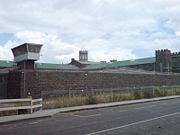
- Further information: Department of Corrections (New Zealand) and List of correctional facilities in New Zealand
New Zealand currently maintains 19 prisons around the country. The Department of Corrections has an annual budget of NZD$748 million and assets worth over NZD$1.7 billion. Official statistics show (as of June 30 2007) that there are currently 7,605 prisoners within the New Zealand correctional system. (5,490 Sentenced Prisoners and 1,552 Remanded Prisoners) + 5,795 staff. Breakouts are only at 0.15 per 100 prisoners and there is a rate of only 15% positive drug results during random drug testing in NZ prisons. [17]
Poland
As of the end of August 2007, Poland officially declared 90,199 prisoners (13,374 pre-trial; 76,434 serving sentences; 391 others; 2,743 prisoners were female), giving an imprisonment rate per 100,000 inhabitants of about 234. The overpopulation rate (number of prisoners held compared to number of places for prisoners) was estimated by the official prison service as 119%.[12]
The growth rate of imprisonment in Poland during 2006-2007 was approximately 4% annually, based on the August 2007 estimate of 90,199 prisoners and the June 2005 estimate of 82,572 prisoners.[18]
Turkey
Prisons in Turkey are classified as closed, semi-open and open prisons. Closed prisons are separated into different kinds according to its structure and the number of the prisoners held. Examples are A type, B type, E type and F type. F types are the ones in which high penalty prisoners are held. Most which are being built today are L types that are for low penalty prisoners.
United Kingdom
- Further information: Scottish Prison Service, Northern Ireland Prison Service, Her Majesty's Prison Service, United Kingdom prison population, and List of United Kingdom prisons {{The Institute of Prison Law}} {{The Prisons Handbook}}
United States
- Further information: Prisons in the United States
Correspondence
Research indicates that inmates who maintain contact with family and friends in the outside world are less likely to be convicted of further crimes and usually have an easier reintegration period back into society. Many institutions encourage friends and families to send letters, especially when they are unable to visit regularly. However, guidelines exist as to what constitutes acceptable mail, and these policies are strictly enforced.
Mail sent to inmates in violation of prison policies can cost inmates "gain time" and even lead to punishment. Most Department of Corrections websites provide detailed information regarding mail policies. These rules can even vary within a single prison depending on which part of the prison an inmate is housed. For example, death row and maximum security inmates are usually under stricter mail guidelines for security reasons.
There have been several notable challenges to prison corresponding services. The Missouri Department of Corrections (DOC) stated that effective June 1, 2007, inmates would be prohibited from using pen pal websites citing concerns of fraud. Service providers such as WriteAPrisoner.com, together with the ACLU, plan to challenge the ban in Federal Court. Similar bans on an inmate's rights or a website's right to post such information has been ruled unconstitutional in other courts, citing First Amendment freedoms.[19] Since most DOCs already post inmate information on their websites, critics claim this is a moot point. Inmates' ability to mail letters to other inmates has been limited by the courts.[20] Inmate correspondence with members of society is typically encouraged because of the positive impact it can have on inmates, albeit under the guidelines of each institution and availability of letter writers.
See also
|
|
References
- ↑
 "Prisons". Catholic Encyclopedia. (1913). New York: Robert Appleton Company.
"Prisons". Catholic Encyclopedia. (1913). New York: Robert Appleton Company. - ↑ International Profile of Women’s Prisons (144p), International Centre for Prison Studies, April 2008
- ↑ 3.0 3.1 Smith et al, 2002
- ↑ 4.0 4.1 4.2 4.3 4.4 4.5 4.6 Andrews and Bonta, 2003
- ↑ e.g.Moffit T E, Caspi A, Harrington H and Milne B J (2002) Males on the life-course persistent and adolescence-limited pathways: Follow-up at age 26, Development and Psychopathology, 14: 179 - 207
- ↑ Andrews et al, 1990
- ↑ 7.0 7.1 Walmsley, Roy (October 2006). "World Prison Population List (Seventh Edition)" (PDF). Retrieved on 2007-12-15.
- ↑ Harrison, Paige M., Allen J. Beck (June 2006). "Prison and Jail Inmates at Midyear 2005". Bureau of Justice Statistics.
- ↑ "One in100: Behind Bars in America 2008" (PDF). Pew Charitable Trusts (2008-02-28). Retrieved on 2008-02-29.
- ↑ "Prison population statistics". Retrieved on 2007-10-04.
- ↑ 11.0 11.1 "World Prison Population List (Seventh Edition)" (PDF). Retrieved on 2008-07-22.
- ↑ 12.0 12.1 "Statistics - August 2007" (pdf) (in Polish). Prison Service, Poland (Służba Więzienna) (August 2007). Retrieved on 2007-10-07.
- ↑ This value includes 501 prisoners per 100,000 in prisons ("US Bureau of Justice Statistics, Prisons" (2005). Retrieved on 2007-12-15.) and 256 prisoners per 100,000 in jails ("US Bureau of Justice Statistics, Jails" (June 2006). Retrieved on 2007-12-15.).
- ↑ Official Prison Statistics of Germany (from the German statistics office)
- ↑ Prison Archive (from the University of Bremen)
- ↑ http://www.cili.in/article/viewFile/1380/984
- ↑ Corrections Department NZ - Facts and statistics
- ↑ "Statistics - June 2006" (pdf) (in Polish). Prison Service, Poland (Służba Więzienna) (June 2006). Retrieved on 2007-10-07.
- ↑ "Arizona Inmates Back on the Net". Wired News (2002). Retrieved on 2008-01-26.
- ↑ "Prisoners’ Rights – Legal Correspondence". FindLaw. Retrieved on 2008-01-26.
Further reading
- David Denborough, Beyond the Prison: Gathering Dreams of Freedom, Adelaide, South Australia: Dulwich Centre Publications 1996.
- George Jackson, Soledad brother, ISBN 978-1556522307.
- Heinz Sobota, Der Minus-Mann. Heyne Verlag 1980, ISBN 345301111
- James (Jim) Bruton, Big House: Life Inside a Supermax Security Prison, Voyageur Press (July, 2004), hardcover, 192 pages, ISBN 0-89658-039-3
- Marek M. Kaminski (2004) Games Prisoners Play. Princeton University Press. ISBN 0-691-11721-7
- Mark L. Taylor. The Executed God: The Way of the Cross in Lockdown America. Augsburg Fortress Publishers, 2001. ISBN 0-8006-3283-4
- Michel Foucault, Discipline and Punish: the Birth of the Prison, New York: Random House 1975.
- Paula C. Johnson, Inner Lives: Voices of African American Women in Prison, New York University Press 2004.
- Stover H, "Overview study. An assistance to drug users in European prisons, "EMCDDA", 2001, 305p, ISBN 1 902114 03 5
- Ted Conover. Newjack: Guarding Sing Sing. Knopf, 2001. Trade paperback, 352 pages, ISBN 0-375-72662-4
External links
- America's Hardest Prisons
- Australia's Hardest Prison
- World's Hardest Prison: Banged Up Abroad
- Blogs from prison, 2006. Summary of a cultural extension workshop in a juvenile detention facility.
- Home Office, UK - Justice and prisons
- Peter Kropotkin, In Russian and French Prisons. Online book. This is a criticism of the existence of prisons.
- Prison Statistics - US Bureau of Justice Statistics
- Wil S. Hylton. "Sick on the Inside: Correctional HMOs and the coming prison plague". Harper's Magazine, August 2003.
- World Prison Population List (fourth edition) UK Home Office, 2003. ISSN 1473-8406.
- 37 years of asylum life for seeking police help
- 31 years in prison, without crime or ever being produced in court
- 35 years in Jail on cooked-up charges
- Mother raped in prison, son born there and imprisoned till the age of 40
- Innocent girl sent to prison at the age of 15, for 55 years
- Innocent woman joins relatives after 45 years
Title: Overview study. An assistance to drug users in European prisons. Editor(s) Stover H Publisher: Lisbon: EMCDDA Publication Year: 2001 Pagination: 305p ISBN 1 902114 03 5 Call No. MO4, HK, VH4 Document Type Book Notes includes bibliographical references. A5, ringbound
